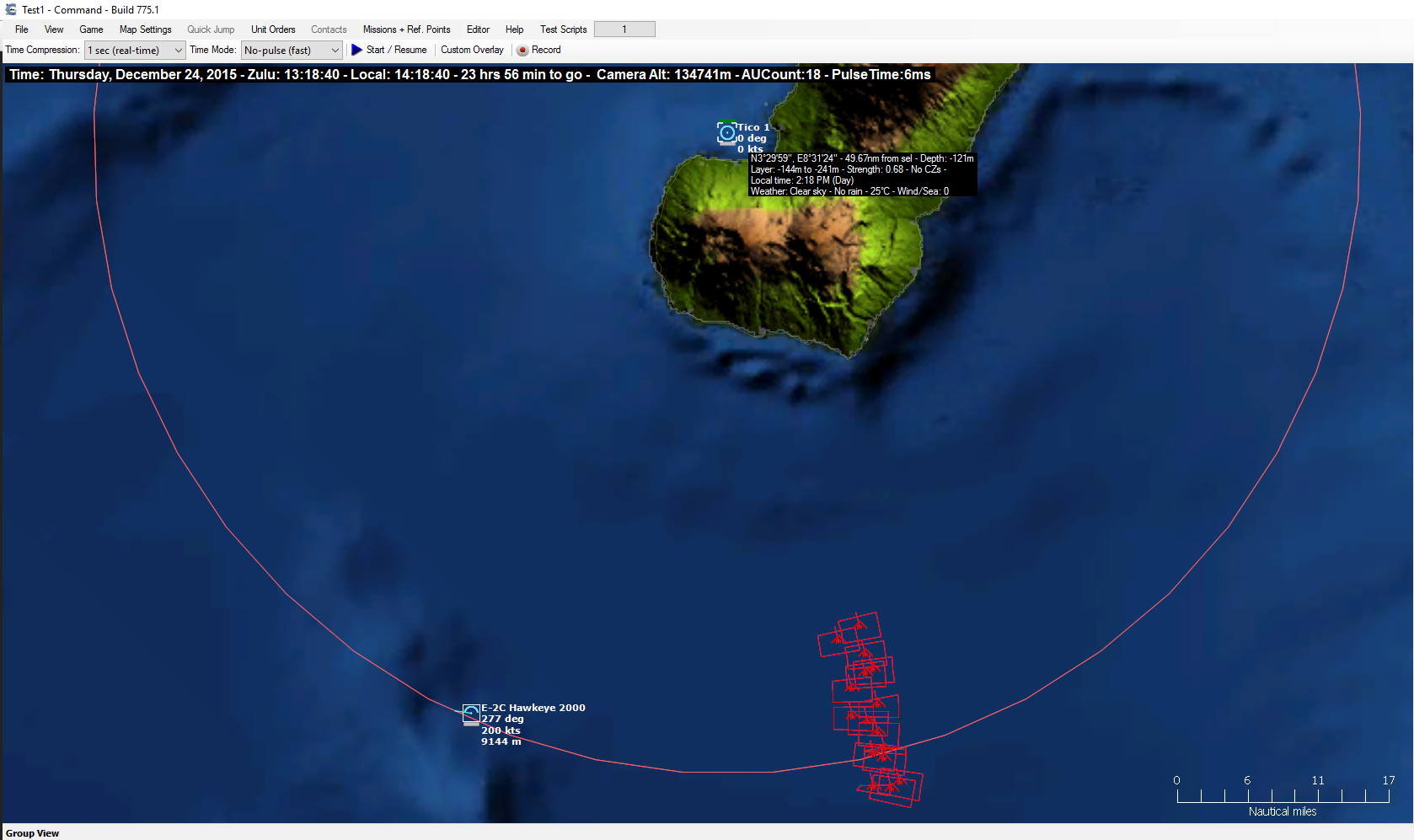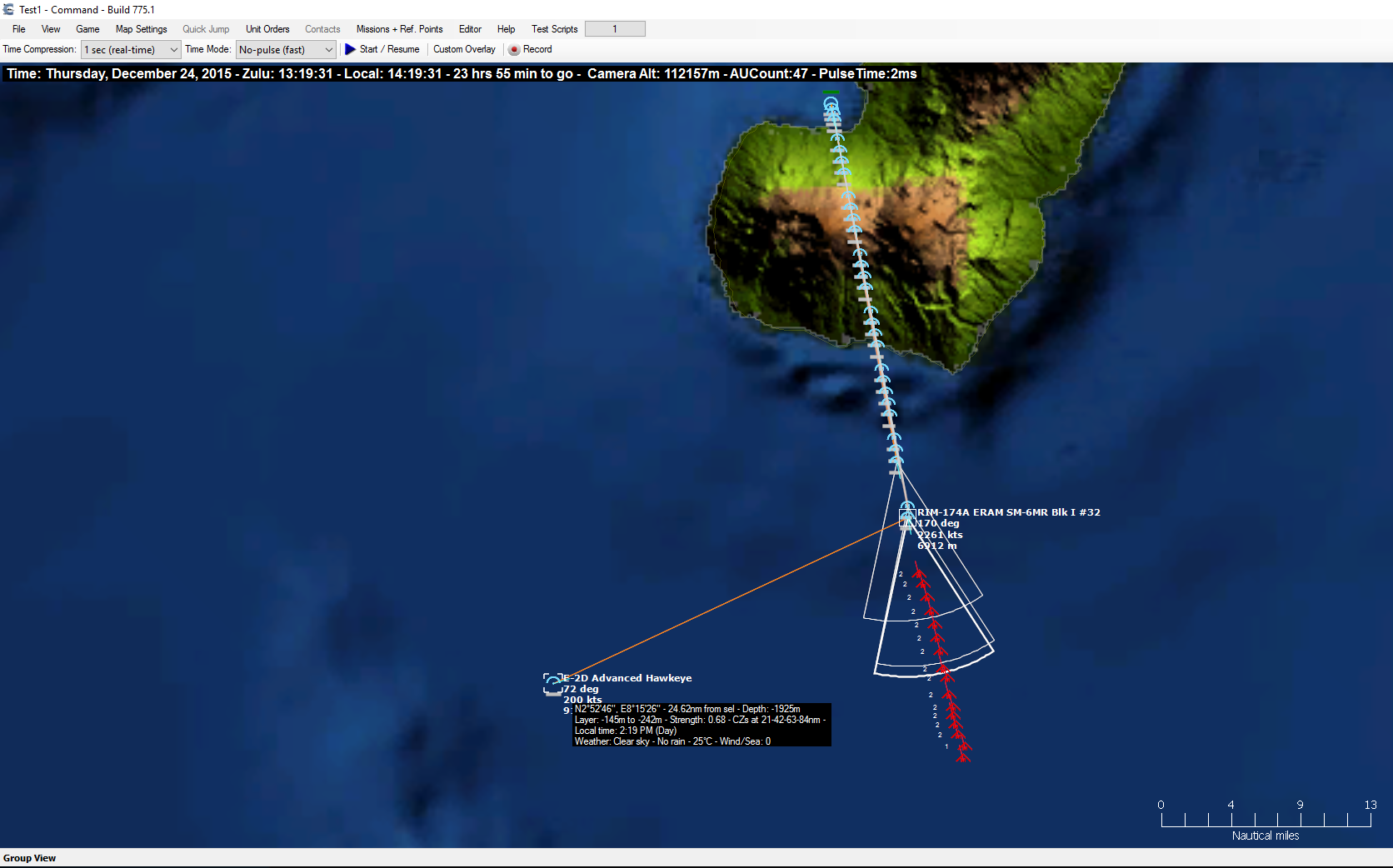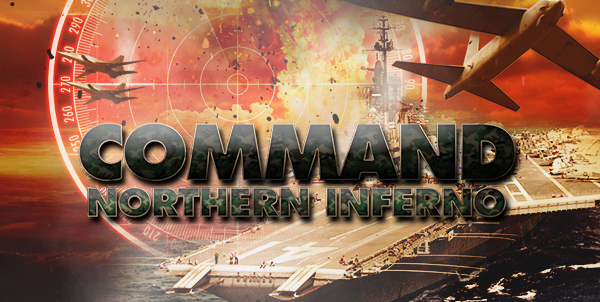The road to v1.10: New weaponry capabilities
Happy holidays everyone!
Command Build 757.12, which had been made available unofficially at the start of December, has now officially been released through MatrixGames and Steam. Barring any emergencies, this is probably the last update released as part of the post-v1.09/NI release support process (Command is still 50% off at MatrixGames and Steam until early January!). The development team’s focus is now the next major public update, designated v1.10. Let us take a look at the some of the major improvements that the new version will feature.
Cooperative Engagement Capability (CEC)
 New to the term? Here’s a quick primer. TL/DR version: You shoot the weapon (and often get out of harm’s way), I guide it to impact; typically by mid-course datalink, less frequently so by terminal illumination (e.g. radar or laser).
New to the term? Here’s a quick primer. TL/DR version: You shoot the weapon (and often get out of harm’s way), I guide it to impact; typically by mid-course datalink, less frequently so by terminal illumination (e.g. radar or laser).
Strictly speaking, this capability is not new. The Russian Navy already had since the early 1960s the ability to use its Tu-95RT Bear-D aircraft and Ka-25RT Hormone-B helicopters as airborne relays to “shepherd” heavy carrier-killer missiles launched from surface ships or submarines towards their targets. The US later introduced some weapons like the Walleye II ER-DL, the SLAM, the AGM-130 etc. which allow a different aircraft from the launch platform to guide them. And then of course there is the ubiquity of the buddy-lazing paradigm. What is new nowadays is that computers and networks have matured to the point where this guidance model is fast/responsive enough to be used against air targets.
Perhaps unsurprisingly, the first operational application of CEC emerged in Sweden in the late 90s, where Gripen-C/Ds of the Swedish air force were able to perform AMRAAM “blind shots” based on offboard shared data. But now with the emergence of NIFC-CA in the US Navy, CEC is going mainstream.
In a simulation like CMANO and its older siblings, it is tempting to take the “easy route” for modelling this ability by simply allowing everyone to guide everything. This creates problems in the sense that it does not really highlight the increased combat capability of the new systems. What is the AIM-120D good for (other than improved kinematics) if older versions of the AMRAAM offer the same guidance flexibility in-sim? So something stricter becomes necessary.
The implementation followed by the CMANO dev team allows great flexibility (database-wise) in defining that a given datalink component may allow cooperative use when installed in platform-A but not so when installed on platform-B. The same goes for different generations of the same basic weapon (e.g. AMRAAM-D vs. earlier versions). This allows modelling the differences in capability without having to spawn multiple versions (CEC-enabled and non-CEC) of the very same datalink system. It also highlights the necessity of bringing all the basic pieces together to really exploit the new functionality. For example an F-15C may tote the new AIM-120D but without any CEC-compatible platform (such as an E-2D or CEC-updated Aegis cruiser/destroyer) in the vicinity, it cannot really do a true launch-and-leave.
Let’s see how all these acronyms benefit the virtual commander. (Click for full size)
This is a typical nightmare scenario for an Aegis cruiser: The ship is operating in the littoral, close to high mountains that sharply reduce its visual and radar horizon. An attack by multiple supersonic sea-skimming missiles against the ship is underway. While the orbiting E-2C has provided early warning, this is not helping the ship significantly: the target tracks are imprecise and the Tico cannot engage the missiles because it is blocked by the mountains (the ship’s SM-2 missiles require terminal radar illumination). By the time the missiles pop over the mountain ridge and can be engaged, it will be too late.
Let’s observe the same situation with CEC-enabled assets in place.
The orbiting E-2D uses a new improved radar which enables establishing firm target tracks. The big change, however, is that now the cruiser has CEC-enabled datalinks and SM-6 ERAM missiles, and can start shooting them as soon as the inbound targets enter the kinematic envelope. Notice that most of the ERAMs are still in their midcourse phase (lofted high to maximize range) and still high enough that they can maintain their datalink (brown line) to the ship that launched them. However, the first-to-impact ERAM has already dived below the ship’s horizon and lost LOS to it and thus its connection to it – but the E-2D has taken over guidance for it (brown line between E-2D and ERAM). Effectively the ship is shooting blind and completely relying on the E-2D for guidance. And it works. This is CEC.
ABM Warhead Modifiers
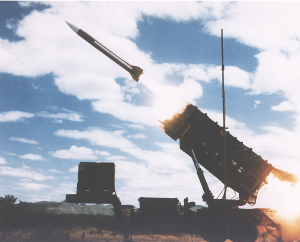 Q: So guys, how can we model the apparently mediocre performance of the Patriot PAC-2 in Desert Storm against Iraqi ballistic missiles?
Q: So guys, how can we model the apparently mediocre performance of the Patriot PAC-2 in Desert Storm against Iraqi ballistic missiles?
A: Well, I guess we can adjust the baseline Pk numbers and the max target speed values so that it behaves well against aircraft speeds but begins suffering at ballistic-speed targets.
Q: Okay, but won’t that also make it unrealistically ineffective against aerodynamic high-speed targets (e.g. SR-71)? From what we know, Patriot is quite effective against anything with wings.
A: True that. Okay, how about we set separate Pk baselines for air targets and missile targets.
Q: That might work, but then you have the problem that PAC-1/2’s handicap was not against missiles in general; it was specifically against ballistic targets. Its warhead, fuzing etc. were optimized against aerodynamic, winged targets and should have no problem working against e.g. cruise missiles (Patriot, like Aegis, was expressly designed with Soviet high-diver cruise missiles in mind). It had no problem intercepting the ballistic targets, but faced severe difficulty in actually destroying them. Most of them were knocked off course or broke up into multiple smaller but still lethal pieces.
Then you also have the factor of follow-on systems learning from the DS experience and improving on the ABM aspect. S-300VM/SA-23 for instance uses a directional-frag warhead (very much resembling a rotating claymore mine on top of a missile) and this has been also adopted by a few other systems, most notably Crotale NG and 9M96. And then of course you have the hit-to-kill trend nowadays with everything from PAC-3 to THAAD to even pure-AAW kits on the table. All these fancy new missiles aren’t actually much better than PAC-1/2 at hitting ballistic targets; they are however much better at actually blowing them away. And that’s to a large part due to their improved warheads. How do we show that?
A: ……..
(Yes, our brainstorming sessions are often like that)
So, we had to do something new. And we did.
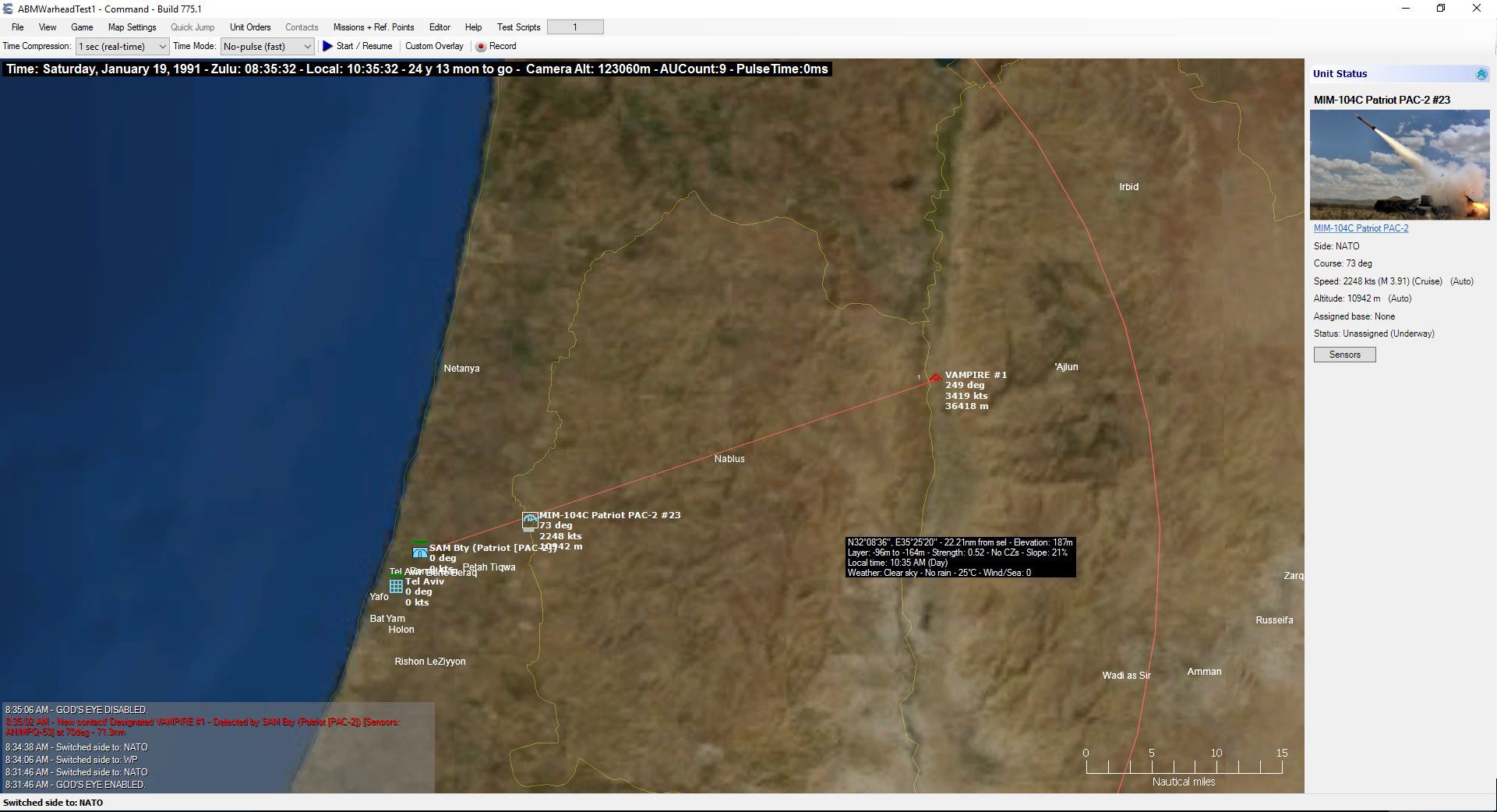 A familiar scene if you’re old enough: An Israeli PAC-2 battery in the outskirts of Tel Aviv engages an incoming Iraqi ballistic missile in the first days of Desert Storm.
A familiar scene if you’re old enough: An Israeli PAC-2 battery in the outskirts of Tel Aviv engages an incoming Iraqi ballistic missile in the first days of Desert Storm.
In addition to the standard continuous-rod warheads, we have added two more types of ABM-optimized warheads: Directional-fragmentation and hit-to-kill (HTK). We also modified the weapon-impact code to account for the special circumstances revolving engagements of ballistic targets (missiles & RVs).
This is what now happens when a SAM/ABM impacts an incoming missile/RV:
– A conventional warhead has a 15% chance of outright destruction of the target, and a 30% chance of significant trajectory deviation (CEP increased by 3x). If none of these happens then the target missile/RV suffers only a minor deviation (CEP increased by 1.5x).
– A directional-frag warhead has a 30% chance of outright destruction of the target, and a 60% chance of significant trajectory deviation (CEP increased by 3x). If none of these happens then the target missile/RV suffers only a minor deviation (CEP increased by 1.5x).
– A HTK warhead reliably destroys the target every time.
Trajectory deviations are cumulative, so an incoming missile/RV may be impacted multiple times by non-HTK ABMs and still survive but impact far away from its intended aimpoint (this happened in a few instances in DS).
AAW weapons with advanced warheads are also favored by AI crews in “best weapon to use” calculations, as their warheads also make them more lethal on anti-aircraft engagements (having your aircraft literally impaled by a HTK missile must be a relatively unpleasant experience…).
Weapons with advanced AAW/ABM warheads in the DB3000 database include:
- Arrow 3
- ASM-135A ALMV
- GBI [CE-I, GMD]
- GBI [CE-II Blk 0, GMD]
- GBI [CE-II Blk 1, GMD]
- KM-SAM [Modified 9M96]
- MIM-104F Patriot PAC-3 ERINT
- MIM-104F Patriot PAC-3 MSE
- R.440 Crotale-NG VT1
- R.440N Crotale-NG VT1
- RIM-161A SM-3 NTW Blk I
- RIM-161B SM-3 NTW Blk IA
- RIM-161C SM-3 NTW Blk IB
- RIM-161E SM-3 NTW Blk IIA
- SA-12a Gladiator [9M83]
- SA-12b Giant [9M82]
- SA-21a Growler [48N6DM]
- SA-23a Gladiator [9M83M]
- SA-23b Giant [9M82M]
- SA-25 [9M96]
- SA-25 [9M96D]
- SA-N-21c Growler [9M96]
- SA-N-21d Growler [9M96D]
- THAAD C-1
- THAAD C-2
One-click EMP strike
 EMP effects from nuclear detonations are not new; we introduced them already in v1.09 and they have been a lot of fun to use and experiment with. They were not however easy to use from an end-user perspective unless one was willing to get down and dirty with Lua in the scenario editor. v1.10 changes that. Now even aunt Elma can paralyze your country.
EMP effects from nuclear detonations are not new; we introduced them already in v1.09 and they have been a lot of fun to use and experiment with. They were not however easy to use from an end-user perspective unless one was willing to get down and dirty with Lua in the scenario editor. v1.10 changes that. Now even aunt Elma can paralyze your country.
The trick in smoothly integrating EMP attacks on existing weapon mechanics (and especially UI) is to make as few data changes as possible. In the real world, any nuclear warhead that can be lofted at high altitude (ideally near-orbital) is a crude but effective candidate for a continent-wide EMP strike (the physics of EMP propagation were a constant source of amusement during our research; the realization, for instance, that detonation altitude determines effective reach much more so than warhead yield). Would it be possible to simply make EMP-oriented copies of all nuclear ballistic missiles in the DB? It would, but it would create lots of logistical problems and would deprive players of the real-world flexibility of selecting the attack mode at the last possible moment.
So we created a framework for such “special mode” weapon attacks:
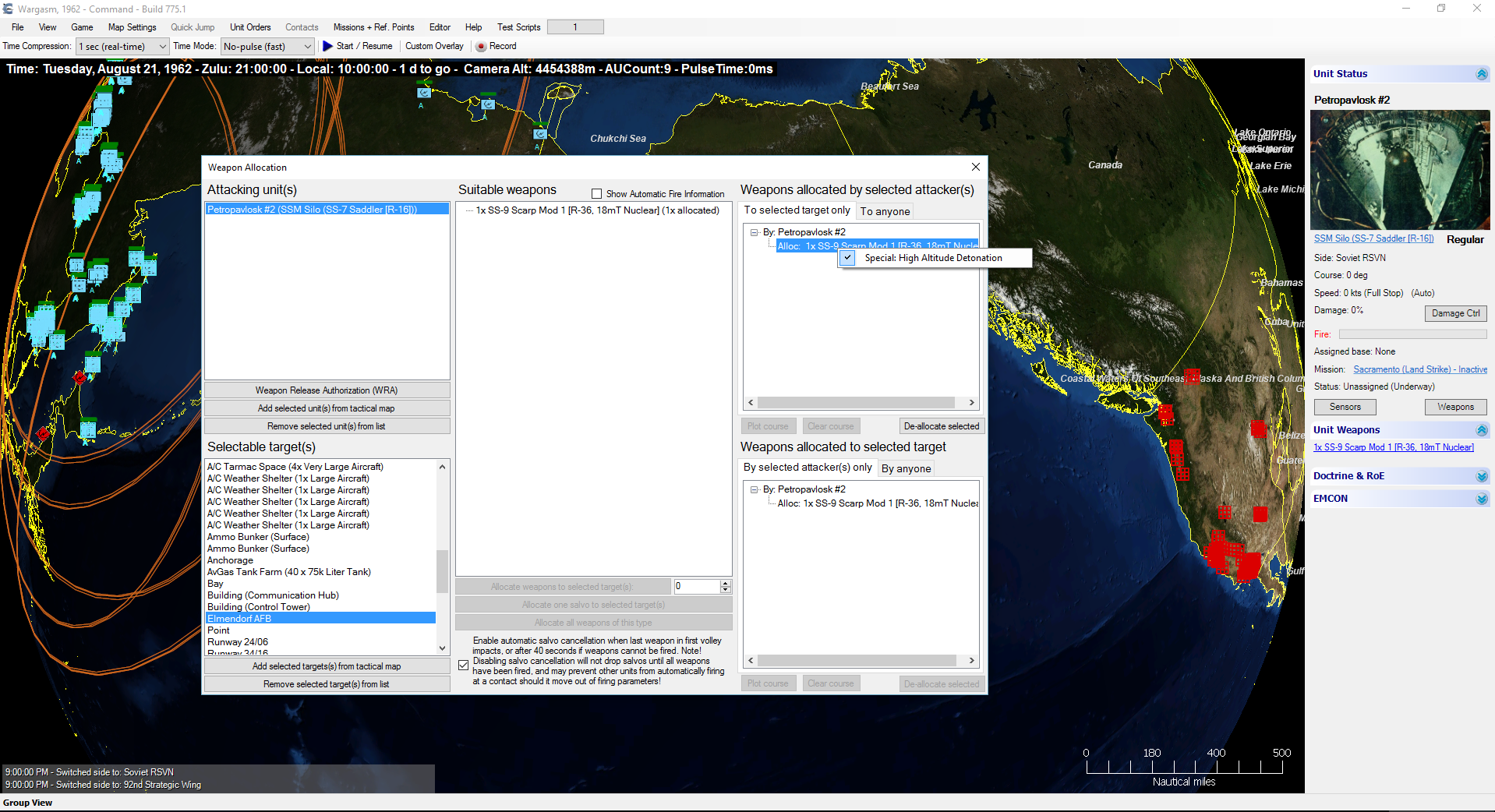 What is better than throwing a 18-megaton warhead at Elmendorf AFB? Why, bursting that same warhead high over Elmendorf and frying every transistor in Alaska and western Canada of course!
What is better than throwing a 18-megaton warhead at Elmendorf AFB? Why, bursting that same warhead high over Elmendorf and frying every transistor in Alaska and western Canada of course!
There is not much to say beyond the obvious: When you select this attack mode, the ballistic missile will detonate at high altitude instead of the normal low altitude airburst or groundburst (depending on target type) that nuclear warheads typically go off at. This ensures a powerful pulse extending out to more than a thousand km and knocking out sensors and communication systems. Such an “opening gambit” attack is in fact a common threat scenario when considering rogue nuclear states like Iran or North Korea.
Suffice to mention, the same framework can be re-used for other special weapon attack types in the future.
And there is much more to talk about….
The road to v1.10: Steam Workshop
Command Build 757.12, which had been made available unofficially at the start of December, has now officially been released through MatrixGames and Steam. Barring any emergencies, this is probably the last update released as part of the post-v1.09/NI release support process (Command is still 50% off at MatrixGames until early January!). The development team’s focus is now the next major public update, designated v1.10. Let us take a look at the some of the major improvements that the new version will feature.
Steam Workshop Scenarios
With the release of v1.10 one important new feature is Steam Workshop integration, giving players a new avenue to share and discover scenarios!
One quick note we here at Warfare Sims would like to point out that the new Steam Workshop functionality will in no way supersede the existing scenario distribution channels (the community scenario pack and the matrix scenario forum). The wildly successful community scenario pack showcases the very best of the scenarios released to date and will continue to be released periodically with additional updates. In fact highly rated Steam Workshop scenarios will find their way into the community scenario pack.
Submitting a scenario to the Steam Workshop couldn’t be easier!
First, open Command via Steam. Then, open the scenario you would like to upload in ‘edit mode’. After that press the “Publish scenario to Steam Workshop” button near the bottom of the Editor menu.
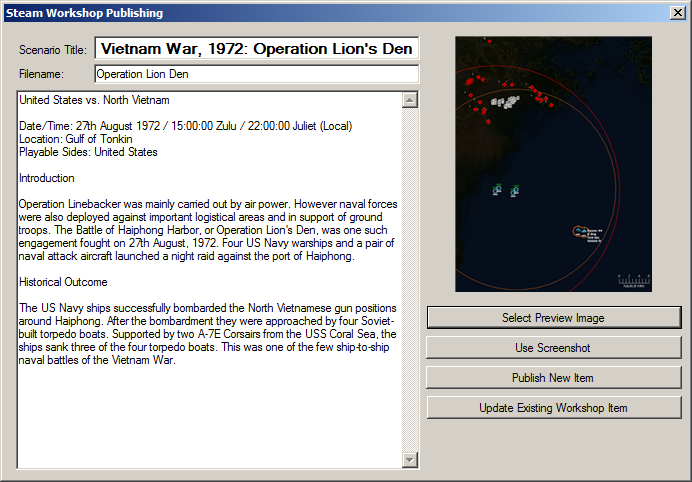
Attach a special preview image, or use the screenshot of the action on the screen as the thumbnail for the scenario.
After that it’s as simple as pressing ‘Publish New Item’. Its sent off to Steam, and made available on the Steam Workshop immediately!
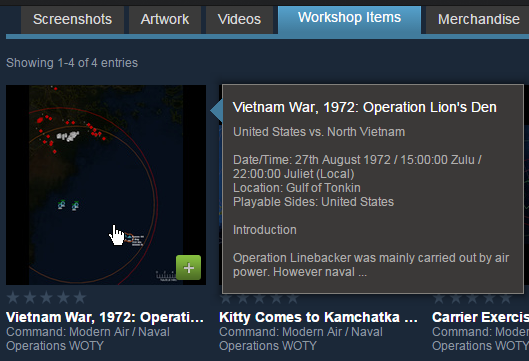
Now, to download this scenario you must subscribe to the scenario.

After hitting that ‘Subscribe’ button the next time you open Command via Steam the scenario will be downloaded to a special new folder in your Scenario directory.
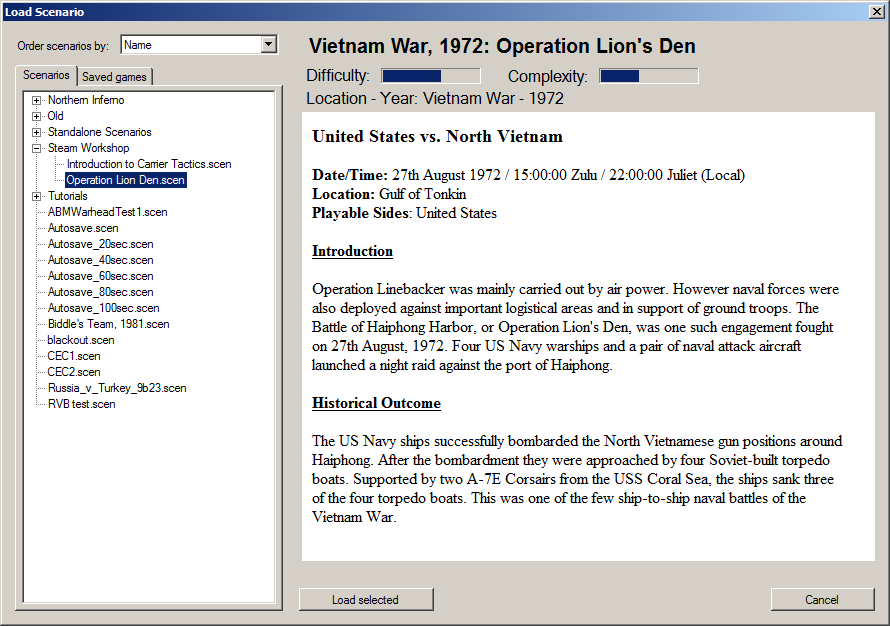
The Steam Workshop allows scenario authors to be able to auto-update their scenarios, an author can make a change to a scenario and update the existing item on the Workshop and then this update will automatically be sent to all those who ‘subscribe’ to the item.
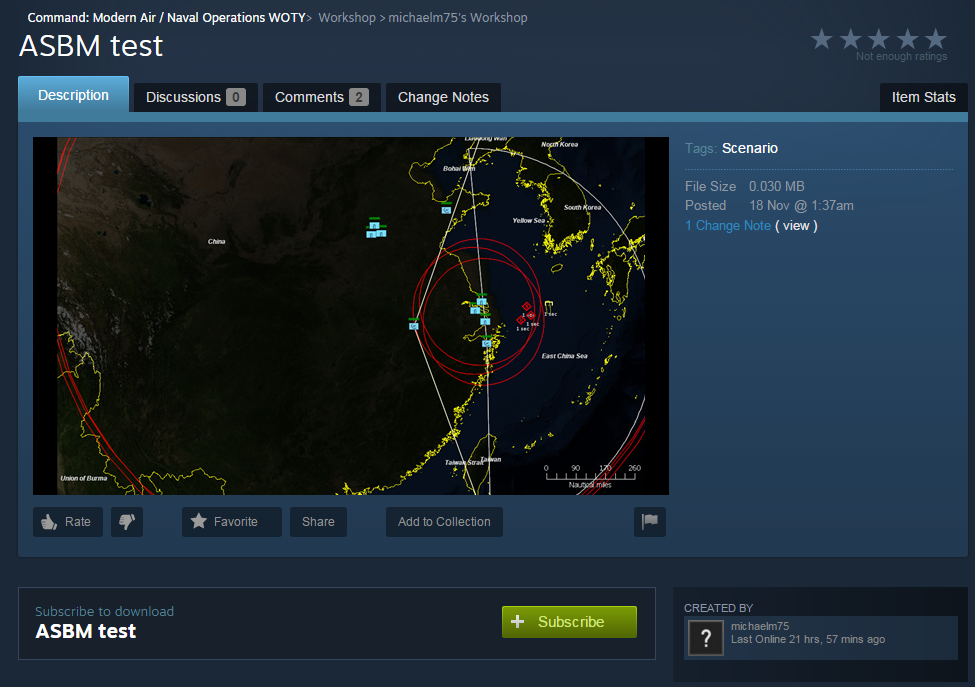
We look forward to taking a look at the scenarios you upload! The inclusion of Steam Workshop in v1.10 introduces a whole new way to share scenarios, in addition to the already existing channels of scenario distribution!
The road to v1.10: Waypoints for cruise missiles
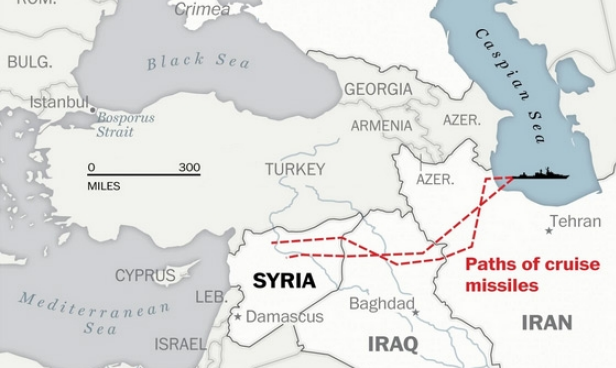 Command Build 757.12, which had been made available unofficially at the start of December, has now officially been released through MatrixGames and Steam. Barring any emergencies, this is probably the last update released as part of the post-v1.09/NI release support process (Command is still 50% off at MatrixGames until early January!). The development team’s focus is now the next major public update, designated v1.10. Let us take a look at the some of the major improvements that the new version will feature.
Command Build 757.12, which had been made available unofficially at the start of December, has now officially been released through MatrixGames and Steam. Barring any emergencies, this is probably the last update released as part of the post-v1.09/NI release support process (Command is still 50% off at MatrixGames until early January!). The development team’s focus is now the next major public update, designated v1.10. Let us take a look at the some of the major improvements that the new version will feature.
Complex missile courses for fun and profit
Arguably one of the most visible changes in v1.10 is the new ability to plot complex routes with multiple waypoints for cruise missile attacks. While this was already possible for weapons under positive datalink control (e.g. heavy Russian “carrier killer” missiles like the SS-N-19), this is now possible also for completely autonomous weapons. Let’s see how this works.
In this completely hypothetical example, the USS Ohio, loaded with Tactical Tomahawk (TACTOM) land-attack cruise missiles, is tasked to attack the air facilities at Latakia airbase in order to hamper Russian air operations from this important base. The airfield is protected by a battery of Pantsir-S1 short-range air-defence vehicles and, most importantly, a full S-400 long-range air-defence missile battery.
From the position that the Ohio is currently located, a direct missile attack would appear the most obvious course of action. However, we have already tried this on a previous test run and observed that the airfield’s location (placed on a ~40m elevated plateau overlooking the Syrian coast) offers a near-perfect field of view for the air-defence radars located at the base. The results against an attack coming directly from the sea were thus predictable:
Even with a large-scale missile strike, the majority of the TACTOMs were detected, engaged and destroyed by the S-400 battery well before crossing the coast. Leakers were then engaged successfully by the Pantsir-S1 systems. While some of the missiles did manage to impact their targets, this was more a result of simply overwhelming the airfield’s defences by sheer numbers (the S-400 battery ewas completely drained of weapons, and the Pantsir-S1 vehicles nearly so) rather than outwitting them.
So let’s see if we can execute a smarter, more efficient attack. We observe that the airbase, while having an excellent view to the west, is somewhat lodged between the coast and the so-called “Syrian Coastal Mountain Range“. This ridge could make an excellent radar mask for our TACTOMs if we can get them to attack the base from this direction rather than from the sea.
So let’s do exactly that:
Using the manual weapon allocation window, we assign a salvo of 4 TACTOMs to one of the airfield facilities. We select the salvo (blue outline) and click on the “Plot course” button under it. This temporarily hides the allocation window and allows us to plot the desired course:
In this case we set the missiles to cross the coast at Lebanon, skirt behind the mountain ridges on their way up north and pop up to attack the base at the last possible moment. Note that we do not have absolute freedom in plotting such courses: We are constrained both by the maximum range of the weapon and also the number of available waypoints to use. This is not a problem for TACTOM, but numerous anti-ship missiles have only a handful of waypoints available.
This is the result of the revised attack, from the Russian point of view:
The difference is quite dramatic. The 96L6 (Cheese Board) radar that supports the base defences detected the first TACTOMs at just 12.8nm, as they popped over the mountain ridge. Combined with the inevitable OODA delay, this gives the Russian SAMs very little time to react. If the TACTOM strike is as massive as before, the Russian repair crews at Latakia are going to have a very busy day…
Units under AI control are also able to utilize missile waypoints to their benefit. Although not currently able to “think” about radar/SAM coverage as in the above example, they nevertheless attempt to make off-axis attacks whenever possible (this obviously depends on how much weapon range they can spare) in order to hide their true bearing from their target. No longer does the bearing to a detected incoming missile provide an immediate clue to the attacker’s location:
The inclusion of missile waypoints in v1.10 introduces a whole new range of tactical options based on RL operations, and we are certain the players will find even more uses for them (complex TALD/MALD flight paths anyone?).
WW3 epics, Biddle’s capers, Korean chaos and Blackbird shootdowns: Fifteen new Command scenarios available
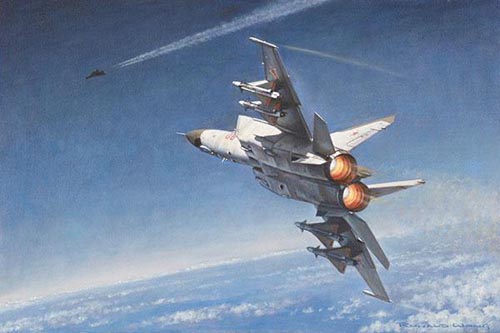 Miguel Molina has posted a new revision of the community scenario pack, the compendium of Command scenarios crafted by the user community. The new release contains fifteen brand-new scenarios:
Miguel Molina has posted a new revision of the community scenario pack, the compendium of Command scenarios crafted by the user community. The new release contains fifteen brand-new scenarios:
Biddle’s Team, 1982: Three weeks after the assassination of Anwar Sadat on October 6, 1981, Egypt has slipped into political chaos. A Soviet surface group is currently en route to offer support to the pro-Soviet faction now struggling for control. The United States, however, has recognized a pro-Western faction as the legitimate government of Egypt, and has no intention of allowing Egypt to turn into a Soviet puppet state.
Biddle’s Quandary, 1982: The Middle East has become increasingly unstable since the assassination of Anwar Sadat in 1981. Egypt has avoided total collapse, but militant groups have been responsible for numerous acts of terrorism in the last several months. Evidence suggests that Syria and Libya have been sponsoring some of these terrorist groups. The US has moved some of its ships near Syria as a show of force, hoping the proximity of American military might will discourage further acts of terrorism. Egypt has sent one of its patrol boats into the area as well. Syria, however, has responded by threatening to attack any vessel that violates its territorial waters.
Biddle goes to Algeria, 1984: Tensions have increased between the United States and Algeria in the early 1980s. To increase presence in the region, a small force centered on the cruiser Biddle is tasked to patrol defensively off the Algerian coast, screened by RAF aircraft from Gibraltar.
Fall of Seoul, 1950: North Korean forces have crossed the 38th parallel and invaded South Korea, in violation of UN agreements. This scenario covers the first three days of fighting for the US forces in the Korean war. Your tasks are as follows:
* Coordinate an evacuation by air and sea from Seoul to US bases in Japan.
* Establish air superiority over South Korea.
* Conduct tactical interdiction against communist advance south of the 38th parallel.
MINUSMA, 2015: The atrocities commited by the rebel groups in Mali’s north has taken a turn for the worse. The UN has authorized airstrikes to support the Malian goverment in its push to once again retake the north of the country. To support the UN’s mission in Mali, Sweden has deployed its fighter jets abroad for the first time since the Congo Crisis. You are to employ airstrikes to weaken the rebels ability to wage an effective fight towards the goverment and you are to provide reconnissance support for the Malian goverment if requested. Collateral damage or friendly losses will not be tolerated!
Norrland Defense, 1990: Defense of Norrland and its strategically important F 21 Luleå Airbase and Luleå Harbour from a pre-emptive Soviet strike in preparation for a full blown invasion.
Defend the Luleå airbase against Soviet assaults and engage the Soviet ships and submarines reported in the area.
Sandbox Scenario #1: Surface Encounter, 1991: In this adaptation of scenario “Surface Encounter” from the boardgame “Harpoon: Captain’s Edition”, an Arleigh Burke-class destroyer is escorting a Whidbey Island-class LSD in the Norwegian Sea and it happens to detect a Soviet Sovremenny-class destroyer with an Ivan Rogov-class landing ship. A skirmish ensues with both sides trying to sink the other’s escorted ships. The Soviets win a victory if they sink the LSD while the US wins if it can sink the Rogov.
To Kill A Mockingbird, 1979: This scenario pits the Soviet air defenses on the Kola Peninsula against the legendary SR-71 – and against the equally-legendary Soviet command chain bureaucracy! To win this mission, you must not only shoot down the dreaded Blackbird, but also do so only after receiving Moscow’s permission. Better yet, you will not know where and when exactly the secretive plane is coming – this mission is designed to be dynamic and will play differently each time. Sometimes you will have a good shot, while other times the Habu will elude you entirely.
USS Midway vs Cuba (The War That Never Was), 1989: When WW3 breaks out in the early 1990s, it spreads everywhere, quickly. One exception has been Cuba, issuing an open letter of neutrality to everyone. However, Cuba is now planning on entering the war. The Soviet Union has instructed them to enter the war just as the US is sending the first of their heavy divisions towards Europe. What if Cuba did enter the war at this percarious moment? All that the US has standing between an entire nation’s armed forces and the lifeline to Europe is the USS Midway, fitted with a scratch SAG and reserve F/A-18 squadrons. Can they hold the line?
Northern Fury 9.2 – Changing Of The Guard, 1994: The situation in the North Atlantic remains desperate. The rapid capture of North Norway and Iceland have allowed the Soviets to surge almost 100 submarines into the Atlantic. The USS Enterprise CVBG spent two difficult days blunting an attempt by the Red Banner Northern Fleet to interdict the sea lanes, she is now preparing to retire for re-supply and re-organization, as are the major Soviet surface units. The USS Eisenhower, after three days of hard fighting in the Mediterranean, has passed through the Pillars of Hercules and is heading north. She will join the USS Carl Vinson CVBG to strike at Soviet forces around Iceland in three days. As the NATO player you must safely withdraw the Enterprise CVBG and replace it with the Carl Vinson CVBG in a holding area south of Iceland. As the WP player you have multiple submarines and significant air assets at your disposal. Your task is to sink one or both US aircraft carriers.
Northern Fury 9.3 – Command At Sea, 1994: The USS Carl Vinson CVBG is moving up to relieve the Enterprise. The USS Eisenhower, after three days of hard fighting in the Mediterranean, has passed through the Pillars of Hercules and is heading north. She will join the USS Carl Vinson CVBG to strike at Soviet forces around Iceland in three days. As the NATO player you must maneuver and protect the USS Mount Whitney as it transports the Commander of the US 2nd Fleet (NATO’s CINCLANT) to a patrol area off the Azores. As the WP player you have multiple submarines and valuable intelligence indicating that a ‘High Value Target’ is arriving in your patrol area.
Northern Fury 9.4 – Cutting The Tether, 1994: This is a small but critical scenario in the battle to isolate Soviet forces on Iceland. Since taking the island of Jan Mayen in the first hours of the war, the desolate spot on the Greenland Sea has become a critical link in Iceland’s supply chain, a long and arduous tether back to the Kola Peninsula. Your job in this scenario is to cut that tether.
Northern Fury 9.5 – Here Comes The Cavalry, 1994: The US 2nd Fleet is now ready for its first counter-attack. The 1st phase has the USS Eisenhower and the USS Carl Vinson CVBGs strike at Soviet forces around Iceland. In order to neutralize the significant Soviet forces on Iceland, your task is to move north and establish local air superiority over the Keflavik peninsula as a precursor to a large USAF strike tomorrow night. You have 28 hours to destroy Soviet Air Defences over Iceland. Detailed SEAD and Strike tasks will be the Air Force’s job, but you need to clean the airspace to make that possible. You know that there are formidable air defences both on and over Iceland so this will not be an easy task.
Northern Fury 9.6 – Stab In The Dark, 1994: Your task is simple, as the Captain of the Canadian Submarine HMCS Onondaga, infiltrate Soviet ASW defences north of Reykjavik and insert a Special Forces team comprising of 4 Canadian JTF2 (Joint Task Force 2) and 4 British SBS (Special Boat Service) operatives. However you may find that in war – nothing is simple.
Northern Fury 10.1 – Poke in the Eye, 1994: 42 hours ago, your Special Forces team comprising of 4 Canadian JTF2 (Joint Task Force 2) and 4 British SBS (Special Boat Service) operatives arrived in Iceland. Now it’s time to earn your paycheck.
As always, the community scenario pack is available for download at the WarfareSims download section: http://www.warfaresims.com/?page_id=1876
Northern Inferno is unleashed!
Now available on Matrix Games and Steam!




